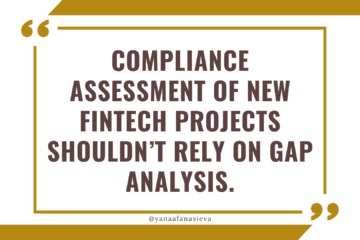Queen’s Gambit Approach to Compliance (aka Sacrifice and Heavy Lifting First)…
I’d like to share with you the concept of Queen’s Gambit and how it relates to compliance, which is a strategy of making a significant initial investment and sacrifices to jump-start new projects and gets the momentum going.
(Yes, I really liked the show and can totally relate to the INTJ protagonist character of Elizabeth. Similar to her, I tend to think in concepts and patterns, have very high expectations for myself, and have very little respect for authorities, mainstream rules, and mediocrity).
If you don’t play chess, the Queen’s gambit strategy involves an early sacrifice of the queen’s pawn in order to secure the strategic advantage.
Many FinTech projects drag forever due to the tendency to do a lot of research, comparisons of alternatives, and other preparatory tasks. People sometimes feel that extensive research is prudent before they make any investments. For example, I have seen cases where the review and comparison of compliance tools took several months, and the tools were essentially identical. Comparing 10 jurisdictions trying to decide where to apply for the FinTech license would be another example.
Recently, I experienced another case of trying to over-prepare, which made me laugh out loud. A client told me that they want to prepare and review all their existing documentation before submitting it to me so that I could review their documents faster and they don’t look so disorganized in my eyes.
To me, this would be akin to thoroughly cleaning up before you invite Marie Kondo to come to your house.
Frankly, it is much easier for me to just re-write and restructure and recreate the compliance documentation for a client rather than explain what was wrong or missing before. Once the structure of the compliance program is set and everything is written in the same style and format and using aligned terminology and cross-references, the heavy lifting is done and maintenance becomes very easy and straightforward.
I know, this approach is very different from the Big4 approach, where the clients are expected to deliver the raw materials or drafts first and then the review will take place. I think Big 4 organizes their workflow that way because their teams and junior analysts typically need time and content to learn about each new client, catch up on the relevant regulations and get up-to-speed.
When clients tell me they use BitGo or AWS or Banking Circle or Bank Frick or Checkout.com or ComplyAdvantage or Elliptic, I already know what it means in terms of their flows of funds or technical setup.
It does take a bit longer to prepare the initial package of documents instead of reviewing them, but then, once all client’s documents follow my templates and format, it is very easy for me to answer regulatory questions or reconcile documents since I know exactly where everything is.
In that sense, Queen’s Gambit is a different mental game. If we agree that the main opponent in the case of compliance projects is time and money (because both are limited), it is important to create an early momentum and faster progress quicker, before the project slows down and starts feeling too complex and overwhelming.
Once I worked with a client who told me that preparing their regulatory business plan before they met me took about 3 months because the project manager was constantly chasing about 10 different stakeholders who were supposed to provide them details of their competitive analysis, marketing strategy, hiring plans, technical diagrams and list of outsourcing providers. This project manager did not feel they were an expert in any of these fields, therefore they absolutely could not move forward without specific input from others. In a strange way, this project was overdue even before it took off, because of inefficient preparation.
Time and time again, the more “traditional” lawyers, consultants, or project managers I meet, the more I realize – there are many great experts and practitioners of their craft, who are very knowledgeable, but many of them are very inefficient and poorly performing as business people. They organize themselves around checklists, and chargeable hours and their idea of progress are having more time, more people, and better clarity when they produce their recommendations.
This is exactly my point: a lot of frictions and misunderstandings in business dealings are eliminated when your service provider or partner and your own company have similar business models, and similar ideas about what is fast and slow, what is good enough, what is growth, or what is risky.
SaaS companies, cloud providers, and FinTechs work well together because they essentially share similar “world views” about risks, speed, and many other priorities. They are technology-intensive or know-how-intensive businesses that are built with the primary desire to scale. They understand that manual operations and human decision-making is the biggest friction point and one of the biggest slow-down factors in their business. Tech and SaaS businesses know their numbers well and understand that human-intense businesses are often subjective, slow, and prone to errors. Tech founders would never measure their success in terms of the number of offices or the number of employees and more likely will talk about the number of users, CAC (customer acquisition costs), conversions, and recurring revenues.
Perhaps, due to the fact that I support ambitious and fast-growing startups, I have internalized the same business model for my own business and applied it instinctively.
We recently talked with one of my accountants about tax planning, and he said, he has never seen a consulting business growing that fast and retaining a very high-profit margin with literally no fixed costs thanks to a highly agile and flexible freelance support structure and almost zero overheads.
I suppose, my advice to you, if you are a FinTech founder, is this: when you hire a service provider, pay attention to the business model and operational style of your lawyers, consultants, or other advisors. If they operate an office-heavy, human-intense, time-insensitive old-fashion business model that looks professional and leisurely on the surface but is actually very slow, expensive, and inefficient at its core, this is where your risk that your organization will be forced to slow down and adopt the tempo, risk appetite and overall operational model of your partner. Inertia is toxic.
Stay tuned!
Tune in to this episode on the Compliance That Makes Sense podcast! – Click here!








